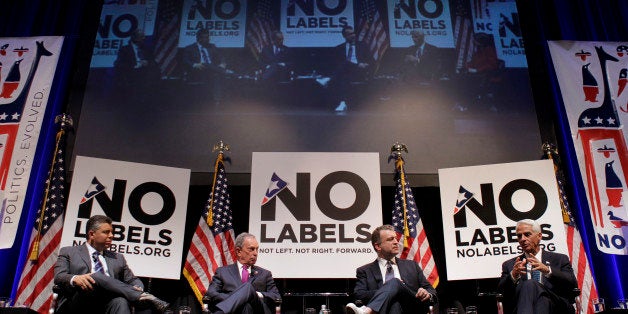
No Labels, a loosely organized collection of platitude wielders, hasn't achieved much in its short time on this Earth. At least as far as its stated purpose of ending partisanship and gridlock, that is. When it comes to infrequently convincing affluent rubes to pointlessly part with their money, the group has been a great success.
But one thing that No Labels has managed to persuade lawmakers to do, on occasion, is sit with one another in "bipartisan" fashion, instead of always sitting apart in their respective caucuses. It's a big thing with No Labels -- part of an "Action Plan To Change The Rules And Fix What's Broken":
It's time to curb the cliques in Congress. At all joint meetings or sessions of Congress, each member should be seated next to at least one member of the other party. On committees and subcommittees, seating also would be arranged in an alternating bipartisan way (one member would be seated next to at least one member of the other party) by agreement between the chair and ranking member. One option would be to arrange bipartisan seating in order of seniority.
It's a very pretty notion, and like most pretty notions, it suffers only because it does not work at all and actually makes things worse. As Mother Jones' Samantha Michaels reports, this is all laid out in a new study by researchers at the University of California, Berkeley, and the University of Toronto, which looks at how "voting behavior change[s] when senators of different parties sit closer together." Per Michaels:
The study's coauthors, business profs Christopher Liu of the University of Toronto and Sameer Srivastava of UC-Berkeley, looked at voting behavior in the Senate from 1973 to 2009. Their findings: Senators from the same party tended to converge in their voting behavior when they interacted more. If they sat closer together or joined more of the same committees, they later voted similarly. But under the same conditions, senators from different parties who interacted more tended to vote differently. In other words, when Republicans and Democrats sit closer together, their votes move further apart.
In a polarized setting like the Senate, the study explains, "conflicting identities will become more salient, and the normative pressure to move further apart in their thoughts and actions will intensify." Translation: "Sometimes keeping some distance is the better option."
Michaels notes that the study "does not lay out any quick fixes for a more cooperative Congress." This is because no quick fixes actually exist, and you should maybe give organizations promising such solutions based solely on gut feelings and the memories of campfire songs a wide berth. (One suggestion that Srivastava does make is to increase the opportunities for lawmakers to deal with one another privately. That is, if you turn the C-SPAN cameras off, you reduce the incentive to grandstand. The idea is not without controversy, as it does force a transparency trade-off.)
But the salient point here is that bipartisan seating doesn't achieve the desired effect of reducing dysfunction. Rather, it ratchets it up a notch. All of which seems to create a somewhat ironic problem for No Labels. Though since No Labels' recent strategy has apparently been to hope for increased dysfunction so that it can secure more fundraising dollars, one can't rule out the possibility that encouraging bipartisan seating is part of the scam.
Would you like to follow me on Twitter? Because why not?

